Not what you’d call a storm for the ages. But with the wind blowing at a steady 20 knots across the Chesapeake Bay, I knew from past trips, that the expected quick, steep chop could make the 98-mile run to Portsmouth, Virginia, our first stop, seem a bit longer.
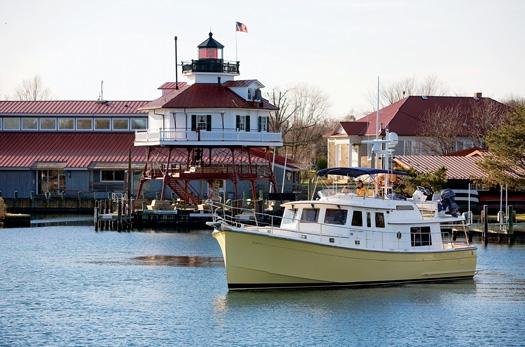
I was just glad to be aboard Daystar, a Krogen Express 52. A distinct chill was in the air and the sky was clear with just a few wispy cirrus clouds when photographer John Bildahl and I arrived at the dock. I had been trying to make arrangements to get myself-and Bildahl, of course-to be part of the delivery crew to take Daystar south from the Chesapeake to Hilton Head. But my travel calendar and that of the boat had not jibed well enough to secure a berth for me. Until now.
Turned out Bob Louden, director of sales and yacht services for Krogen Express along with his wife Machelle, and their 12-year-old daughter Amanda, would be taking Daystar south, leaving from Solomons Island, Maryland. I would be along for the ride until New Bern, North Carolina. The Loudens would push on to Hilton Head.
I didn’t need to sweat that wind. The Krogen Express is an excellent sea boat that made the chop of the Chesapeake little more than an afterthought. The trip was going as expected, with some winddriven spray across the port bow. But we were right on schedule: The boat hummed along at a rock-steady 14 knots.
With all of us comfortably seated within the confines of our spacious wheelhouse, we talked about boats, family, friends, boats, travel and food, pop culture, politics, and, of course, boats. By the time we pulled into Portsmouth’s Tidewater Marina just after sunset, this delivery crew had become a tight group.
While Louden topped off the tanks, Machelle, Amanda, Bildahl, and I got the salt off Daystar, and squared away the salon, galley, and wheelhouse.
Krogen Express is owned and operated by John and Betsy Tegtmeyer. Their business philosophy is refreshing and simple: Don’t try to figure out how to build the most boats, but build the best boat. And when it comes to a coastal cruiser for a couple, the KE 52 is tough to beat.
“It’s the evolution of what we thought was already a good boat but we could make it a little better,” said John Tegtmeyer, of the KE 52 in relation to the company’s previous boat, a 49-footer. “When we purchased the company in 2001, we had our personal opinions. And we interviewed and chatted with all the folks who had purchased the 49 and just asked for their feedback of what they liked about the boat and what they thought could be made better. We incorporated their feedback and our ideas and came out with the 52.” The KE 52 first appeared in the 2003 model year.
The salty-looking, low-profile yacht was designed by James Krogen for serious cruising. The flat chine of the semi-displacement hull provides excellent stability and the boat will begin to plane on the aft chines when enough power is applied, giving a cruise speed of 20 knots. If you want to poke your nose out and run down the coast all night, pull her back to 9 knots for an extended range of approximately 1,870 nautical miles.
The 15-foot, 11-inch beam carries far forward, and, combined with the raised bow section, gives the 52 a spacious interior for the cruising couple. The forepeak master has great headroom and stowage. The cherry finish is light and airy and the boat feels more like a summer cottage. Ports in the forward face of the coachroof are a nice touch, bringing in fresh air and light. The guest stateroom reveals the 52’s couple-cruiser mission. When guests are not on board, it serves as a den, complete with desk and a settee. It’s nice to have more than one social area on any cruising boat. When there is a large party, like with our gang, there is a convertible L-settee, and a Pullman berth. A dayhead is opposite and in the passageway.
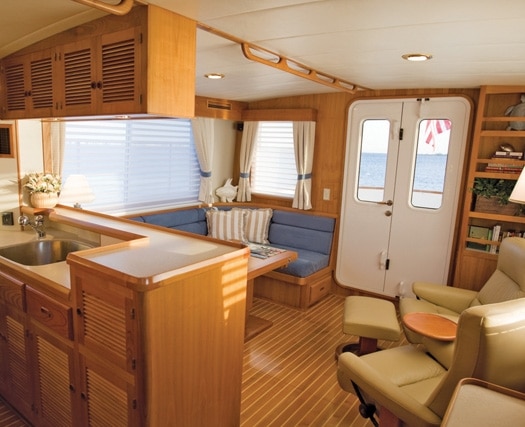
|
The salon and galley are on the same level and the cockpit affords a great seating area. The stand-up engineroom allows for easy access for all critical maintenance areas and systems.
With dinner plans ashore, we left the boat for a leisurely stroll to the historic square-mile district known as Olde Towne. Colonel William Crawford dedicated the four corners of High and Court streets for a church, a market, a courthouse, and a jail on February 27, 1752.
The streets are lined with homes such as 320 Court, built around 1790 and considered to be the oldest in the city still in its original state. At 315 Court, we found a classic revivalstyle house that was occupied by Union General Benjamin “Spoons” Butler during the Civil War. He acquired the nickname after the mysterious disappearance of fine flatware whenever he “inspected” some of the local homes.
And at Washington and North Streets, there is a monument to Commandant Richard Dale who, after being captured no less than five times during the Revolutionary War, managed to escape every time. He was also first lieutenant under John Paul Jones aboard the Bonhomme Richard.
We had our fill of history, now it was time to satisfy other appetites: We dropped into Roger Brown’s place on High Street right opposite the dazzlingly neon-lit, art deco-designed Commodore Theater. As the tasty chicken-wing and rib-bone piles grew higher, we lifted our glasses many times in friendly toasts.
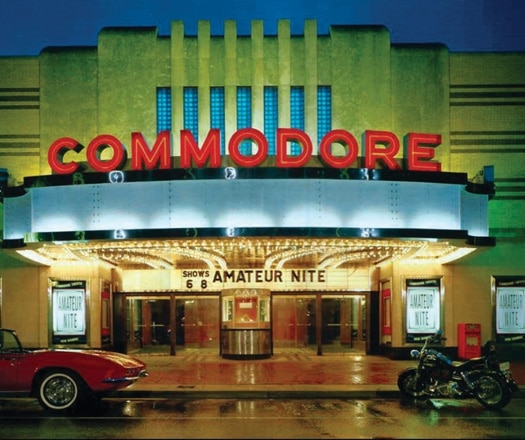
|
We strolled back through the now-empty streets of Olde Towne and to the marina and Daystar. The ladies were given the forepeak master while I had the roomy starboard stateroom. Louden was able to stretch his six-foot, two-inch-plus frame quite comfortably across the elevated wheelhouse watch berth abaft the helm. And Bildahl happily took the cushy salon settee.
As dawn came in a cloudless sky, we had 79 miles to cover to reach Manteo, North Carolina, and our berth at the Waterfront Marina. We had our choice of the bridge helm or the well-designed pilothouse. Often I only think of a pilothouse as an option when the weather turns cold. On our cruise, it certainly provided the perfect perch until the rising sun chased away the morning chill. But there are many of us that want to watch the amount of time we spend in the sun as well. The pilothouse has excellent lines of sight and enough room for a full array of electronics and paper charts. A watch berth aft keeps your mate within earshot while running long night legs.
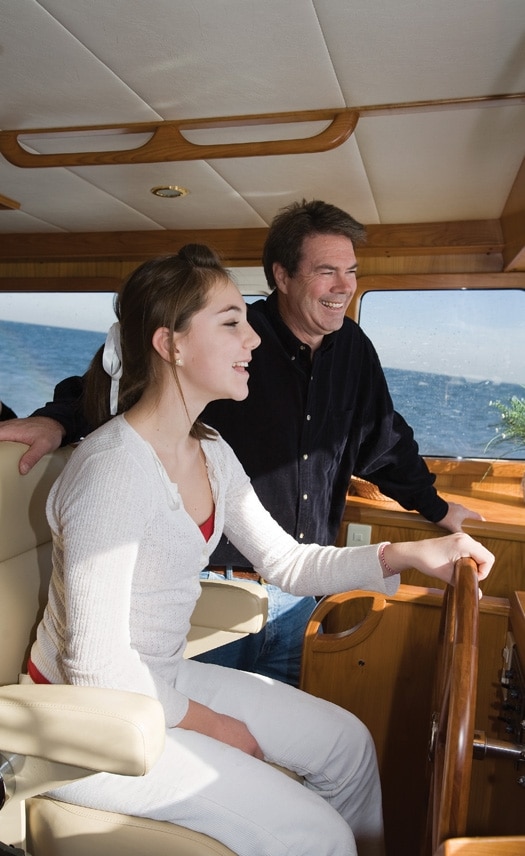
|
We idled through the glass-calm waters, past the red-lighted marker “R36” indicating Mile “0”-the official beginning of the ICW. I gave it a well-deserved bottoms-up with a glass of orange juice. Off to starboard I could see the Portsmouth Naval Hospital, its hallways rumored to be haunted.
The ICW would wind its way for the next ten miles or so until we got to Great Bridge Lock, there to enter into the Albemarle and Chesapeake Canal before traversing the North Landing River. We would then cross Currituck Sound and into the tannin-tinted waters of North Carolina on our way to Albemarle Sound. The dark-tea color is courtesy of decaying leaves and branches from the cypress and juniper trees that line the waterway.
I had put in my wheel time, and with the sun shining and the wind almost nil, I now sat in a comfortable chair in the cockpit and took it all in. I could just see the top of the port bow wake as it swept past amidships and flattened out where I sat, the landscape passing me by. We slowed down and exchanged greetings with a northbound boat, a dog on her foredeck.
I could also see into the salon as Machelle and Amanda worked at a 1,000-piece jigsaw puzzle that now took up most of the teak table there. A pair of cereal boxes was still on the galley counter, evidence of our earlier breakfast. Amanda’s school backpack sat on a chair holding the books she would need to continue working on a project due when she returned from the break. Bildahl and Louden were in the wheelhouse and I would join them shortly.
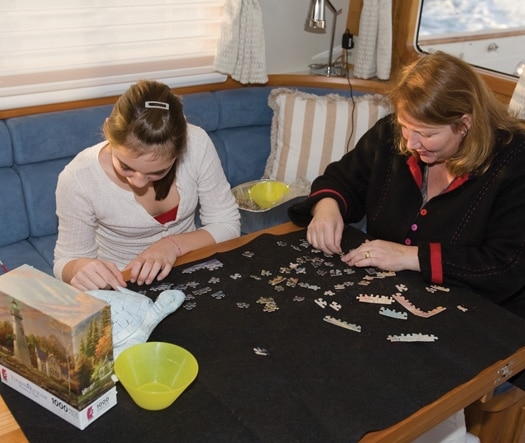
|
But not right now. We were passing Corolla, the most northern town on the Outer Banks. Then it would be Duck, Southern Shores, Kitty Hawk, Kill Devil Hills, and Nags Head. I wanted to savor the moment just a bit longer; of the sun and the way it reflected silver and gold and the intermingling smell of the land and the sea.
We made Manteo with plenty of daylight to spare. As we washed down Daystar, Bildahl headed ashore to take advantage of the spectacular late afternoon light. The town of Manteo sits on the eastern side of Roanoke Island with Wanchese at the southerly end. It takes up less than two square miles and all the shops and restaurants are within walking distance from the waterfront. We all went our separate ways and met up for dinner at Ortega’Z on Sir Walter Raleigh Street.
Our final day aboard Daystar began with a spectacular sunrise. We had some 108 miles to cover before docking at New Bern’s Sheraton Grand Marina and after getting the morning dew off the windows we were underway. The smell of breakfast, of freshly brewed coffee and bacon, fried eggs, and toast filled the interior as Machelle and Bildahl whipped up a true mariner’s feast.
Perfect running conditions awaited as we left Croatan Sound and entered Pamlico Sound and motored past the southerly Outer Banks, on our way to arrive at New Bern at about three in the afternoon. As we crossed the southern end of Pamlico Sound beneath a cloudless sky, the Outer Banks became a broken line of smudges.
As I looked at the chart plotter I noticed Gum Thicket Creek to our east and Brown Creek to the west. We began to pick up some southbound traffic, a pair of trawlers and six sailboats, as we entered the Neuse River. We would pass the town of Oriental on our way to New Bern, where our travel schedules would diverge once again.
Krogen Express, (866) 457-6436; www.krogenexpress.com









